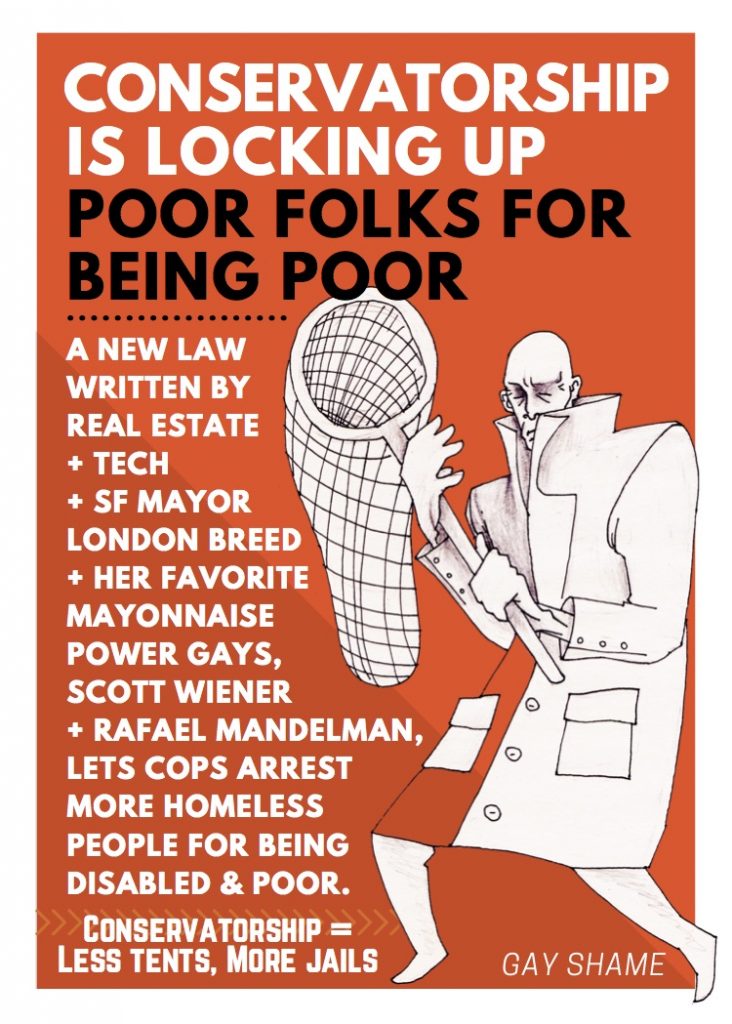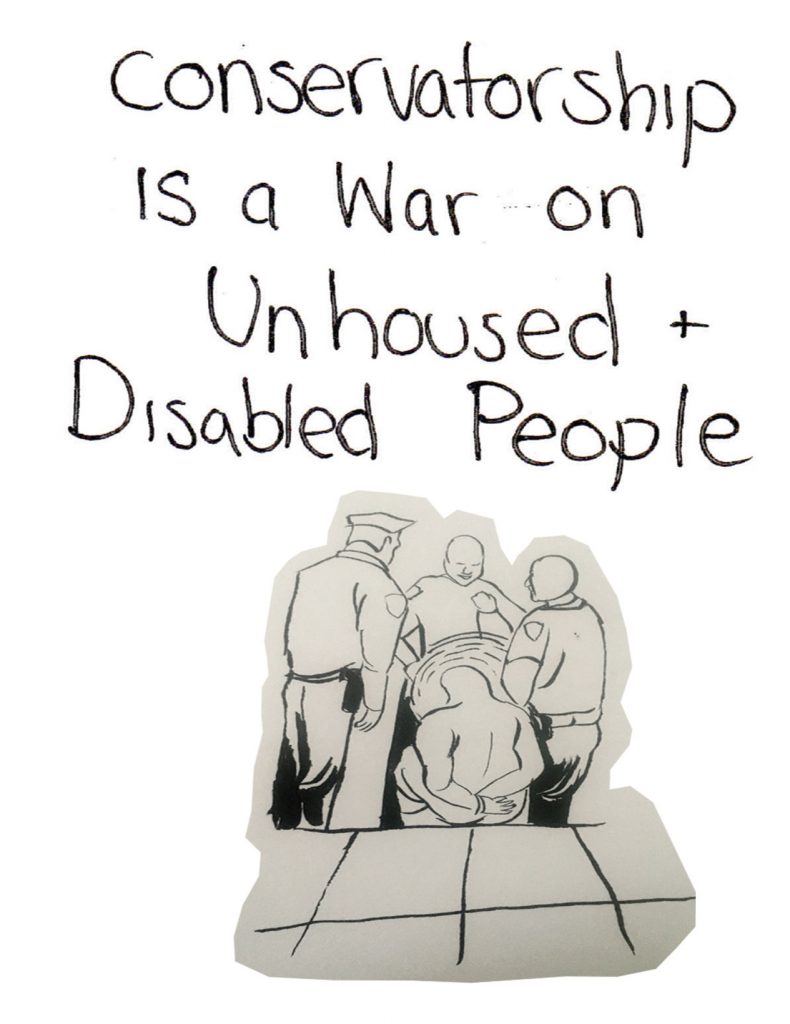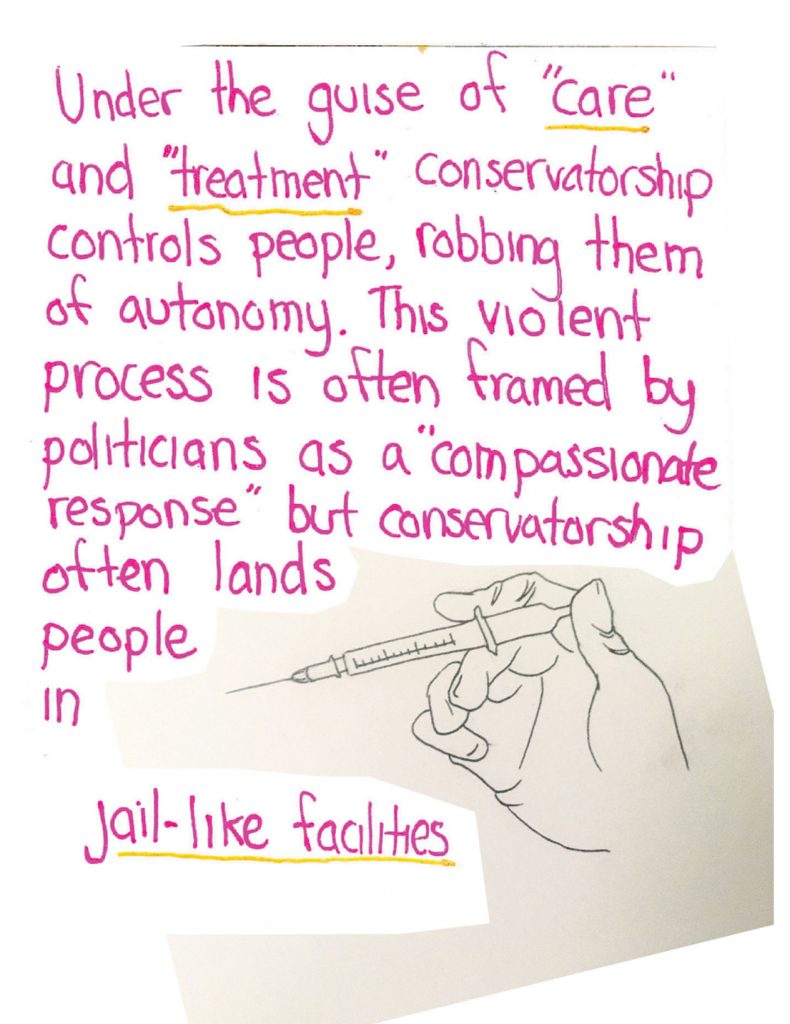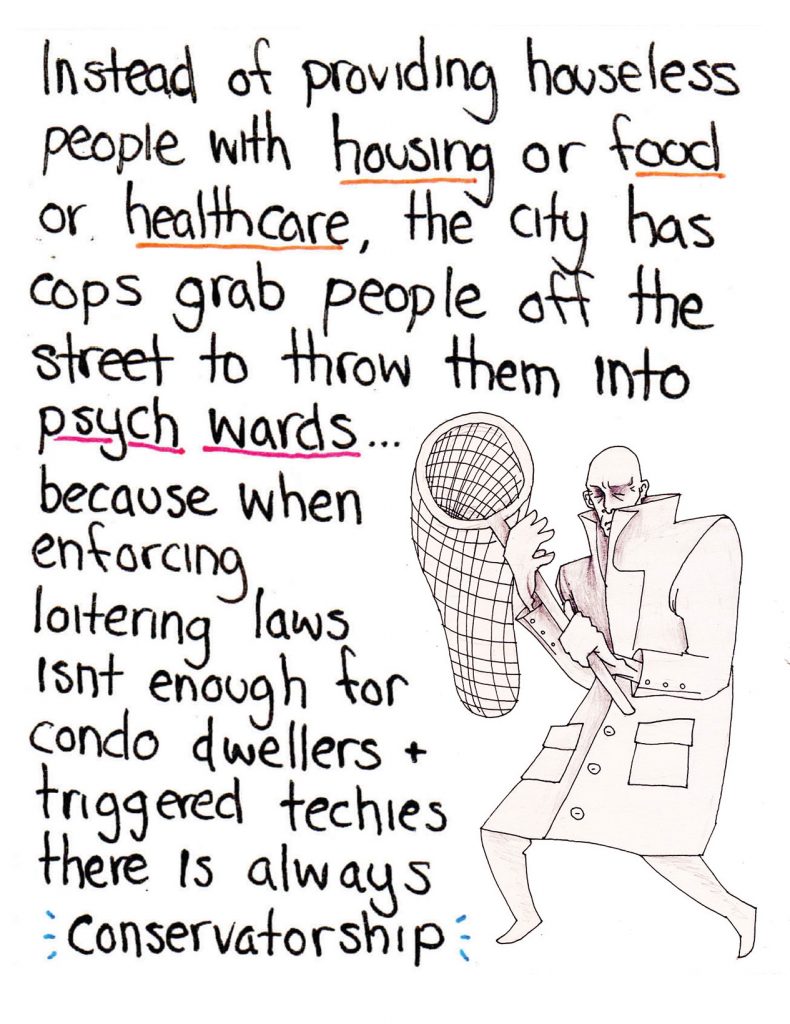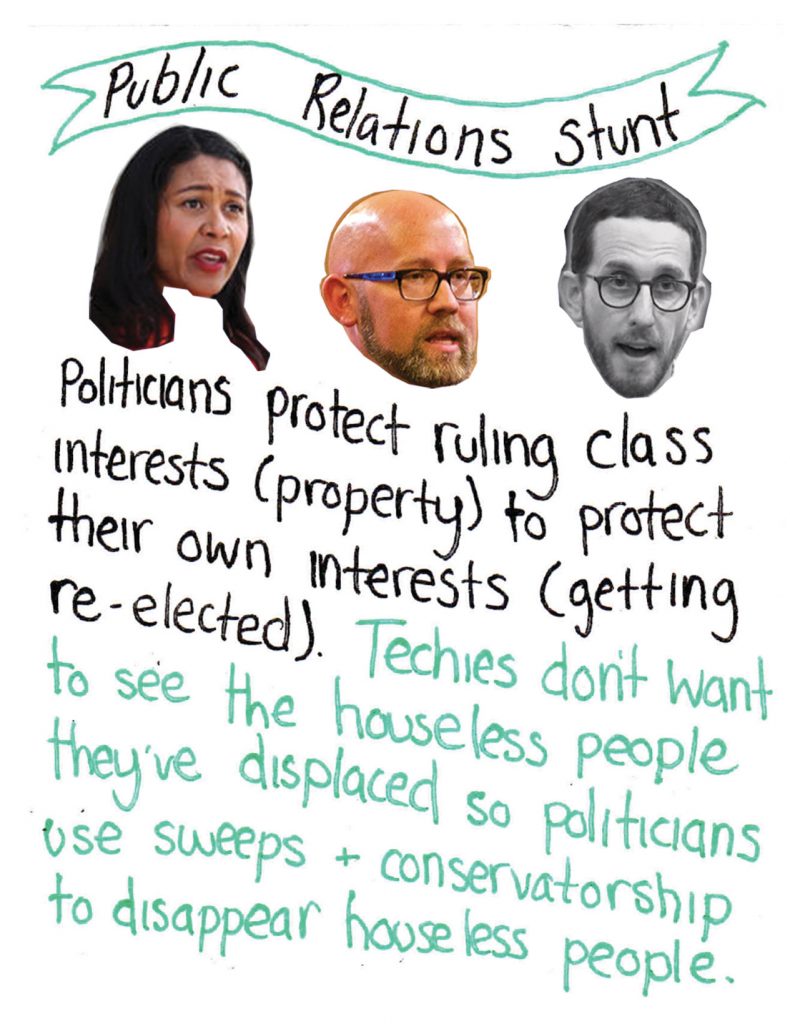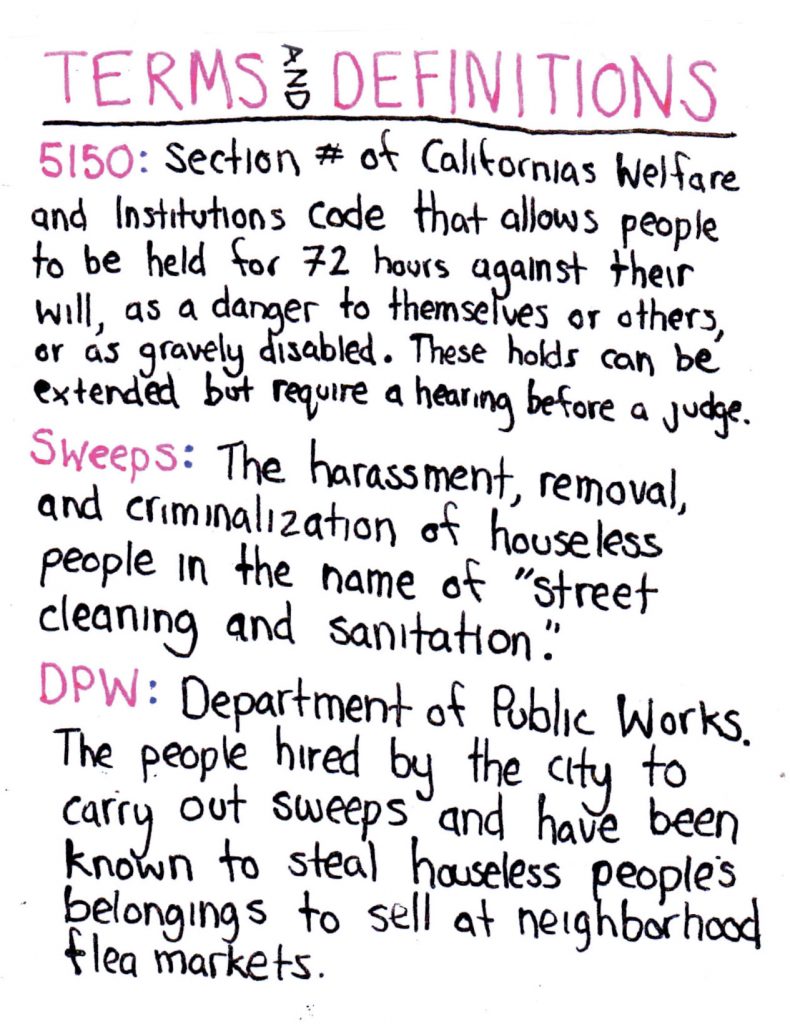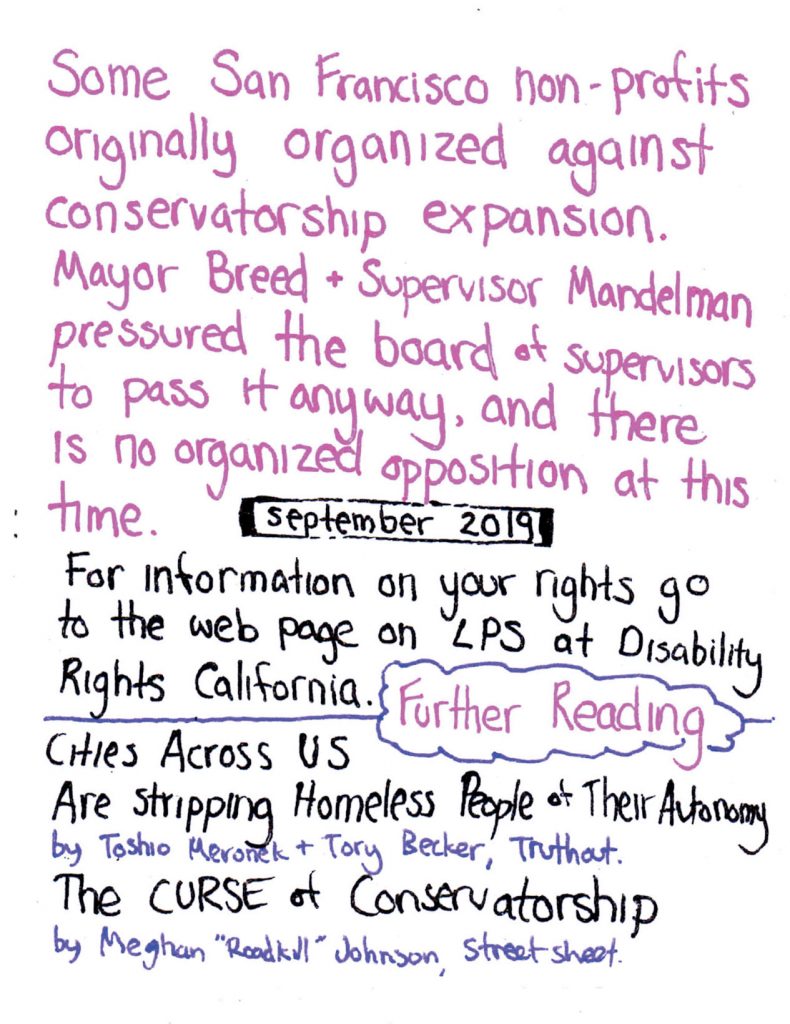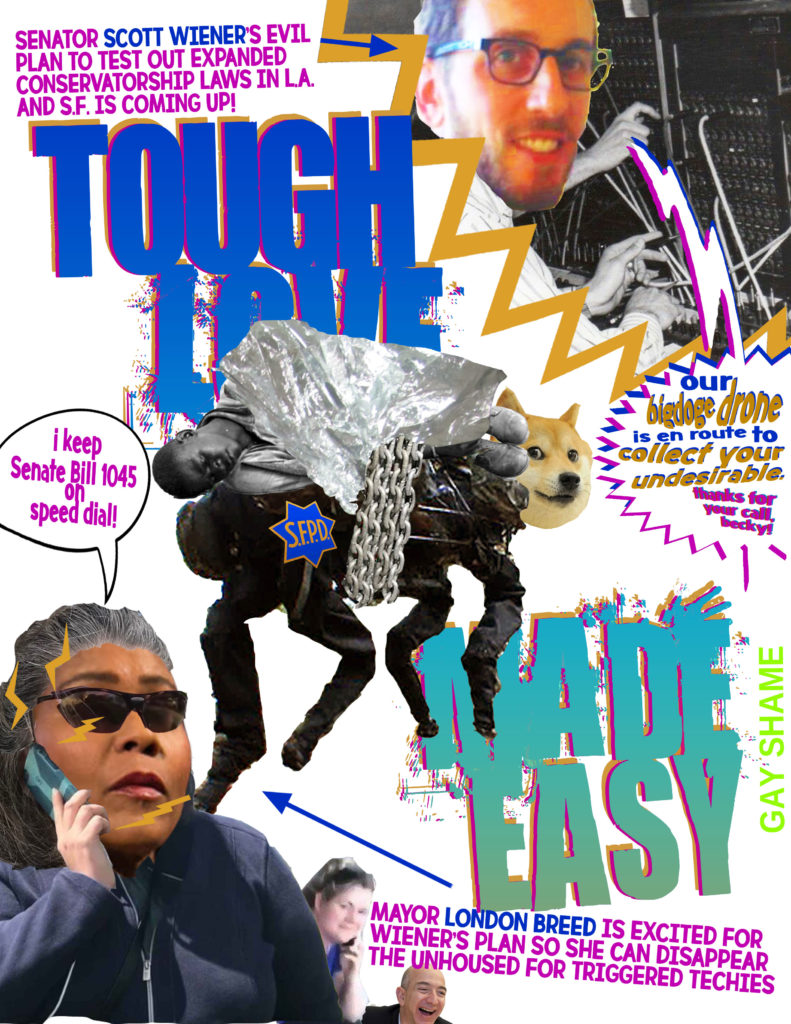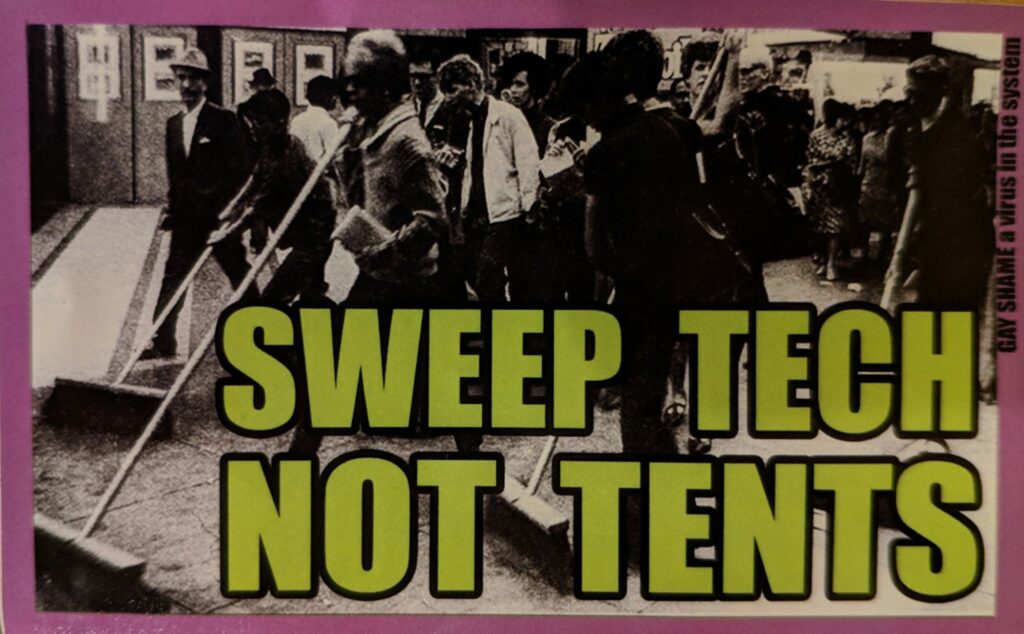
Cities Across the US Are Stripping the Homeless of Their Autonomy
Toshio Meronek and Tory Becker
Tags: Asylum, California, Disability Justice, Gentrification, Homelessness, Miami, San Francisco, Wealth Gap
Summary: Disability justice and civil rights activists organize against “conservatorship” laws that make it easier to strip homeless, disabled people and drug users of the right to make their own decisions.
One of the world’s richest cities is waging war on disabled and homeless people.
In February 2018, an unsigned flyer was posted in San Francisco’s Mission District, warning the homeless: “If you are still here after dark tonight, the hunters will become the hunted. We will pound you, burn you, beat you, and fuck you up if you are within a 100 yards of this park starting after sun down tonight.”
The flyer was eventually tied to Jason Perkins, a local club owner. The government of San Francisco sides with Perkins as it routinely dumpsters homeless peoples’ tents (famously reprimanding a city worker who refused to throw them away); builds “hostile” architecture to discourage poor people from spending time in public spaces; and uses water hoses on those who don’t move along quickly enough.
The city’s latest weapon against the homeless is a law that recalls the era of insane asylums. In San Francisco and other major metro areas across the country, governments are dealing with this “problem” population by pressing pause on disabled and homeless peoples’ ability to make the most basic of decisions, through a scheme called “conservatorship.”
Conservatorship, also known as “guardianship,” puts decision-making for conserved people in the hands of strangers assigned to them by the courts, or sometimes relatives with whom they may or may not have good relationships – taking away their self-determination and often locking them up in jail-like facilities, allegedly for their own protection.
Susan Mizner is a San Francisco-based lawyer who helped create the ACLU’s Disability Rights Program in 2012 and previously headed up the San Francisco government’s Office on Disability. At an October meeting of a coalition of California civil and disability rights groups called Voluntary Services First, Mizner called “conservatorship the biggest deprivation of civil rights aside from the death penalty.”
Imade Borha works at the Mental Health Association of San Francisco, a nonprofit that connects people with mental health issues with peer mentors. Borha was a graduate student in New York when she began to experience bouts of chronic depression that led to two stints in psychiatric wards. After graduating from Columbia with a degree in creative writing and working for two years at a Maryland newspaper, Borha moved into a role in communications for a mental health organization. She changed paths because, she said, “Your voice doesn’t matter in [many psychiatric institutions], and I don’t want anyone else to feel that way.”
Borha described the “chaotic” upper floors of the Weill Cornell Medical Center where she was conserved: On “any given day, people were getting restrained; there was always yelling, and I was afraid I was going to get sexually assaulted.” She protested her alleged “rehabilitative treatment,” telling anyone who would listen – psych staff, case workers – “This is making me worse; I need to be in a safer environment.” Frustrated, she raised her voice – after which point Borha was restrained, threatened with injection and put in an isolation room.
“We don’t call it ‘solitary confinement’ in the hospital; we call it the ‘isolation room,’ but it’s the same practice of placing the most distressed people into silos where they’re not heard,” Borha said. “There’s nothing therapeutic about that.”
The “Ugly” Past
Involuntary holds for people who have disabilities or drug use issues aren’t new. Notorious “ugly laws,” which made it legal to imprison people with visible disabilities simply for being out in public, existed in the US for more than a century. In 1867, San Francisco was the first city to institute such laws. At a November 30, 2018, forum on conservatorship, the director of the Coalition on Homelessness, Jennifer Friedenbach, described renewed calls for conservatorship as “a return to the ugly laws.”
Most conservatorship laws include some language around civil rights, often in the form of the right to regular court hearings where a judge decides whether or not a person should be allowed to make their own decisions. In 2017, states throughout the US enacted 49 guardianship-related laws, including some reforms to strengthen oversight of the conditions experienced by people who are conserved.
Certain states, though, are expanding laws that confine people with psychiatric disabilities and deprive them of their rights. Several have recently lengthened the amount of time that psychiatrically disabled people and/or drug users can be held against their will. For example, Florida recently extended its base involuntary hold period for people who use substances from 60 days to 90. In California, homeless people and their advocates are mobilizing against a state law that is the brainchild of San Francisco legislator Scott Wiener. Adopted in September 2018, SB1045 broadens current conservatorship laws, allowing three counties with high homeless populations–Los Angeles, San Diego, and San Francisco–to indefinitely confine people with disabilities and/or drug users who have been detained by law enforcement 8 times within the last year. It could serve as a national prototype for taking away the civil rights of homeless people, especially those who are disabled and/or use drugs, according to advocacy groups.
A letter sent to politicians by a coalition of California civil rights groups opposing SB 1045 notes that back in 1959, almost 36,000 Californians were held involuntarily in state-run institutions, some for their entire lives. In California, treatments included forced sterilization, barbaric treatments such as lobotomies and prison-like environments that have inspired many horror films. The work of disability justice activists in the 1970s helped to liberate disabled people from asylums and allowed them greater self-determination. But after California closed down many of these institutions, there was one big problem, according to the Coalition: “promised community-based services and housing never materialized.”
So it goes with SB 1045, which presupposes that people living on the streets don’t want housing and services, and includes no clause guaranteeing clothing, food, housing or health care for the conserved. In legislator Wiener’s own San Francisco, there are more than 1,000 people on the shelter waiting list, at least 8,000 families waiting for public housing (the waitlist has been closed since 2015), and 500 people requesting substance abuse treatment that isn’t available.
“That’s beyond belief – that you have to lose your rights in order to get services,” said Terezie Bohrer, a commissioner on San Francisco’s mental health board, referring to SB 1045. Most politicians seem more concerned with emptying the streets of disabled, low-income people than with providing services for them. The SF Examiner reported that after one of the city’s biggest one-day homeless sweeps in the Mission District in April 2018, 126 homeless peoples’ tents were forcibly removed – often thrown into dumpsters and carted off to a landfill. After losing what amounted to their only homes, only six people were placed in shelters after the raid that day. Officials like San Francisco’s homelessness czar, Jeff Kositsky, and the city’s mayor, London Breed, are clearing encampments en masse ahead of Breed’s re-election bid, attempting to implement SB 1045 under a system that relies heavily on the local police and sheriff’s departments.
As advocacy groups have pointed out, SB 1045 and similar laws could lead to an expansion of the prison industrial complex, multiplying medical jail wards across the state, and “mental health services” within jails. As Borha emphasizes, police and sheriffs’ departments’ oversight of such programs could easily lead to more life-threatening and traumatic situations like the ones she experienced herself.
Pick One: Freedom or Health Care
Another SB 1045 opponent, Yakira Teitel, is a medical student in her last year in a residency studying family medicine at the University of California, San Francisco (UCSF). In 2016, when five San Franciscans went on hunger strike outside a local police station to protest a string of killings by police, Teitel was moved by the anti-violence message of the strikers, and joined other UCSF students in informally providing around-the-clock health care support to the strikers for more than two weeks. After the strike ended, they formed the Do No Harm Coalition, which melds principles of medical well-being with social justice issues.
SB 1045 is “scary to me as a physician,” Teitel says. Working at the County’s largest public hospital, San Francisco General, she comes across conservatorship cases more often than the average doctor. While SB 1045 was pitched as a way to help people who can’t help themselves, Teitel sees it as a way for a “really marginalized group of people” to become even more criminalized.
Until now, in California, it’s been “really hard” to get someone conserved, and that’s the way it should be, according to Teitel. “You’re taking away all of their medical decision-making, … and putting them in the hands of someone who is essentially a state bureaucrat” – someone who is paid to be a professional conservator for multiple people who “try to act with the patients’ best interests in mind,” but typically have little contact with them – and sometimes no contact at all. In some cases, conserved people may be placed under the care of family members–but relatives may not have the best interests of someone in mind, either: for example, many who end up on the street are there due to domestic violence; LGBTQ youth leave home in large part because they were forced out or abused by their families.
That’s why she feels conservatorship via the medical system, is “the most extreme way we take away someone’s autonomy,” and that, “the idea that we may be making it easier to do that [is] scary” and “dangerous” – because [in the US we] don’t have a system to deal with serious mental health conditions and disabilities, nor many community-based solutions.
The lack of services to implement SB 1045 is just the start, said Teitel. Law enforcement deputies are most often the ones to initiate psychiatric holds, meaning that the people whom cops tend to pick up the most – such as Black, Brown, poor and disabled people – will face even more police terror. According to 2014 data, 60 percent of people killed by police in San Francisco have mental health issues; nationally, it’s about 50 percent. As first responders, police are often called to intervene in situations involving people with mental illnesses. In many cases, their “response” is murder, as the killings of Ezell Ford, Kayla Moore, Teresa Sheehan and countless others show.
In Borha’s case, police were sent to her house during a suicide attempt. The cops tried forcing their way into her home. “It was terrifying,” she said. She added that the privilege of being a graduate student at the time may have allowed her to “articulate why I felt unsafe in that situation” where others targeted for conservatorship might not have the words to . “When that’s your entry point into a quote-unquote therapeutic setting, that sets the tone. When you’re in a state of crisis, it’s hard to respond,” and no response might be seen as “a sign of resisting.” Borha’s voice got quiet as she described the dangers of police contact when someone is both disabled and Black: “It’s like you’re dead before you’re dead.”
Wealth Gaps and Health Gaps
Unequal distribution of resources like housing and health care aren’t the only problem facing homeless people who are victims of what the UN’s highest-ranking official on poverty called the Bay Area and greater US’s “contempt, and sometimes even … hatred for the poor” in a 2018 report.
Raia Small, an organizer with Senior and Disability Action, a Voluntary Services First coalition member, said SB 1045’s emphasis on “taking homeless people off the streets” makes it obvious that the “legislation is an effort to win support from upper-class constituencies who don’t like seeing homeless people in their neighborhoods.” Small’s takeaway seems particularly on point given legislator Wiener and Mayor Breed’s lack of support for a bill to fund homeless services, which passed despite the politicians’ opposition.
“As the population of San Francisco has become richer, it’s politically efficacious to show that you’re ‘tough on homelessness,’” said Small. City Hall recently teamed up with the police department to deploy mobile cop station RVs in homeless-heavy parts of town, such as the central Tenderloin District.
Similarly, neighborhood watch-like groups funded by the city, called Community Benefit Districts or Business Improvement Districts, were dubbed “Homeless Exclusion Districts” by the University of California Berkeley Law School in a report released in August 2018. The authors of the study found homeowner associations and business interests used the funding to increase policing, surveillance and harassment of homeless people, whose voices are excluded from the local decision-making.
The gentrifiers “don’t want to see the consequences of their gentrification,” Borha said. “These are manmade problems.”
The No New SF Jail Coalition, of which Do No Harm is a member, recently asked the city to shift its focus away from increasing conservatorship, and instead toward creating low-income, cooperative housing. The city’s latest housing report shows the vast majority of new residential buildings are affordable only to the richest of the rich. Four-person households making $118,000 per year are considered “low-income,” and eligible for subsidized housing. However, the odds of getting into that housing, which are rented and sold through lotteries, are about 1 in 82.
As of January 8, 2019, the city’s handful of listings required “low-income” renters to make $2,702 per month in order to apply for one of its subsidized one-bedroomapartments. The housing department’s real estate industry-friendly math allows developers to sell a currently listed “affordable” one-bedroom for $456,000 (not including homeowners’ association fees of $480 per month).
Borha reported moving five times in six months, a stressful situation for anyone, but one she recognized as privileged when she spoke with Truthout in her nonprofit’s office in downtown San Francisco, as homeless people lingered, always under threat of police harassment, including in public space. “I had one roommate in conservatorship who dealt with a dual diagnosis: drug abuse and psychiatric challenges.” When the roommate was up for release from the program, “She had nowhere to go,” Borha said. “No one was helping her find a home, but also it wasn’t legal to discharge her to the streets.” She remained captive in the system for months until low-income housing became available to her.
On the other side of the country, the biggest city in Florida – the state that recently expanded its base involuntary hold period to 90 days – is more forthcoming with its homeless exclusion and vilification project.
In 1992, about 5,000 homeless Miamians joined a class-action lawsuit resulting in Miami’s Pottinger Agreement. A federal district court found that treatment of homeless people by the city and its police department amounted to “cruel and unusual punishment.” Two events cited by Judge Clyde Atkins in the court decision were particularly shocking: Twice, cops handcuffed homeless people and made them watch while the officers set fire to their possessions. Their IDs, medicine, clothing and a Bible all turned into a pile of ash.
However, Pottinger is often ignored; attorneys for the ACLU say there were 72 complaints of police violating Pottinger’s stipulations between April and October 2018. Now, the city is attempting to overturn Pottinger, very transparently, in the name of gentrification.
“Demographic” changes in downtown Miami, according to the city’s May 2018 legal filing, make Pottinger’s termination necessary. So, too, do the “90,000 premium square feet of retail,” newly erected condos, the addition of new entertainment and sports venues like the American Airlines Arena and the Live Nation Amphitheater, and luxe hotels such as the JW Marriott Marquis and the Four Seasons. The city claims these developments justify dissolving Pottinger and the policy’s attempt to curb abuse and arrests of homeless people. In fact, the city believes police should have increased power to criminalize mentally ill people and drug users.
The profit potential for locking up more homeless people is huge for the contractors whose bread and butter is imprisonment. GEO Group, the country’s second-largest private prison corporation, expects to make $250 million per year off its 2017 acquisition of Community Education Centers, a halfway-house operator that makes its coin off of treatment contracts with state and local governments in 17 states.
A Downward Spiral
According to the National Institute for Health, housing insecurity is a major stressor that causes mental illness and drug use, resulting in the most vicious of cycles: People with psychiatric diagnoses are vulnerable to homelessness and substance abuse, and lack of investment in basic needs like housing and health care mean more people suffering on the streets.
Even as the government continues to privatize and dismantle the public housing system, a federal program created just a decade ago is one of the few large-scale bright spots: a long-term shelter for veterans (known as HUD VASH) offers housing vouchers to veterans, who make up a disproportionate number of drug users and people with psychiatric disabilities. But the Department of Housing and Urban Development’s (HUD)
Some of the richest people in the US have made it very clear they want their neighborhoods cleansed of homeless people. They might get their wish, thanks to a country-wide battle not against homelessness, but against homeless people themselves.

